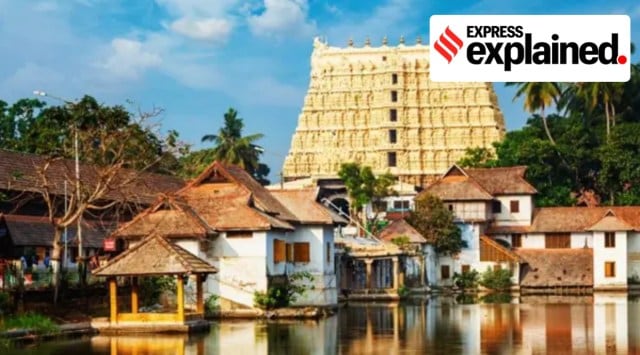Explained: How are temple affairs run in Left-ruled Kerala?
The temples in Kerala do not share their revenue with the state government. Instead, all five autonomous Devaswom (temple) boards have budget allocation from the state government every year.
 Padmanabhaswamy Temple. (Express/File)
Padmanabhaswamy Temple. (Express/File)In an old video being shared widely on social media, former Supreme Court judge Indu Malhotra is seen claiming that Communist governments want to take control of temples with an eye on their revenue. Her remarks have been refused by Kerala’s Left Democratic Front government, which has also pointed out assistance that has been paid to temples under various temple boards in the state.
Who manages Kerala temples?
Kerala has temples that are managed by state-run temple boards, private temple boards, or by community organisations such as Nair Service Society (NSS) and Sree Narayana Dharma Paripalana (SNDP) Yogam, Akhila Bharatha Ayyappa Seva Sangham, Gowda Saraswath Brahmin Sabha, Dheevara Sabha, Vishwakarma Sabha, Ayyapa Seva Samithi, pro-BJP Kerala Kshetra Samrakshana Samithi, apart from families and trusts.
How many state-run temples does Kerala have?
Kerala has five state-run autonomous Devaswom (temple) boards, which together manage 3,058 temples in the state. These are Travancore Devaswom Board (1,250 temples, including famous hill shrine of Sabarimala), Cochin Devaswom Board (406 temples), Malabar Devaswom Board (1,357 temples) Guruvayur Devaswom Board (11) and Koodalmanikyam board (12). The state also has a Devaswom Ministry with the portfolio in the present LDF government being held by K Radhakrishnan.
How do these temple boards function?
Ruling parties appoint their nominees, who are also politicians, as president and members of the temple governing board. Role of these outfits includes administration of the temples, management of temple properties and ensuring facilities and infrastructure for devotees. Meanwhile, temples follow rituals as per tradition, irrespective of the party in power. Travancore and Cochin Boards also run educational institutions, including government-aided colleges and schools. The boards also run institutions to impart training in temple art forms.
How is staff recruited for different temples?
Staff, including priests, are recruited by the respective boards. The previous LDF regime brought in a Devaswom Recruitment Board to streamline the process. In 2017, the Travancore board for the first time appointed Dalits as priests in various temples under it. Later, the Cochin board also appointed non-Brahmin priests. Recruitment to the temples under the boards are done as per Hindu Religious Institutions Act 1951, except for posts which are bequeathed to a family member traditionally. As per the existing norm, SCs get 10% reservation, while STs get 2% share in recruitment.
What about temple revenue?
The temples in Kerala do not share their revenue with the state government. Instead, all five Devaswom boards have budget allocation from the state government every year. Between 2016-17 to 2019-2020 financial years, the state allocated Rs 351 crore for various temples in Kerala. Apart from this allocation, the Travancore board got an additional assistance of Rs 120 crore as 2018 flood relief and pandemic aid. As part of similar crisis assistance, the Cochin board was given Rs 25 crore, while Malabar board was allocated Rs 20 crore, and Koodalmanikyam board got Rs 15 lakh. That apart, after the present LDF regime assumed office in May 2021, the Travancore board was given a grant-in-aid of Rs 20 crore and the Malabar board received Rs 44 crore.
- 01
- 02
- 03
- 04
- 05






































